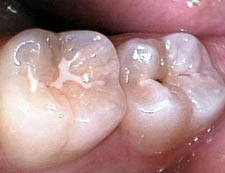Dental Sealants

Dental sealants are items used as part of a dental procedure involving the application of a thin plastic material to one or more teeth to prevent dental cavities and other forms of tooth decay. They are usually painted on the chewing surfaces of the back molar and premolar teeth and are highly effective in the prevention of tooth decay on these areas which hard-to-reach pits and grooves that serve as a host to food debris and dental plaque build-up.
Since the 1970s, the United States has experienced a decline in tooth decay on the smooth surfaces of teeth, partly due to fluoridation in public water supplies as well as improved dental hygiene among the public. But, because the back teeth (molars) contain numerous pits and fissures, certain areas of these teeth could not be properly rid of food particles and bacterial plaque, even with vigorous tooth brushing and flossing techniques. As a result, decay is the molar areas remained nearly unavoidable. The development of sealants during the 1970's changed this.
Application of Dental Sealants
If applied correctly, sealants can be nearly 100% effective in preventing dental cavities on treated teeth. Yet despite their effectiveness and the fact that sealants have been widely available since the early 1970s, it is estimated that currently fewer than 20% of the population have them.
| The process of applying sealants involves the tooth surface first being cleaned with a cleaning agent gel. This cleaning agent makes the surface of the tooth rough. It is then rinsed to remove traces of the cleaning agent and allowed to dry. Then a solution containing a thin layer of liquid plastic material is applied to surface of the tooth, including the pits and fissures areas. After the plastic liquid is applied, a blue spectrum natural light is shined on the material to cure (harden) the plastic. There are also some brands of sealants that cure by a chemical process without the use of light. After the area is cured, the liquid plastic turns into a hard, thin layer covering the treated portions of the tooth. |
Caring for Dental Sealants
After the process, dental sealants can remain effective for a period of five years or more. They do wear naturally and should be checked at regular follow up dental visits. If the sealant wears or become damaged, it can be repaired or replaced by applying new sealant material to the worn or damaged areas on the tooth. Sealants become less effective when all or part of the bond between the tooth and the sealant is broken. Therefore, it is important to have a dentist repair the seal as quickly as possible.
Because dental sealants act as a physical barrier to decay and dental plaque, in most cases, they can provide 100 % protection. The most important variable is how well the dental sealant adheres to the teeth. In addition, research has shown that sealants actually stop cavities when placed on top of a slightly decayed tooth. This is because it seals off the supply of nutrients to the cavity causing bacteria.
Dental sealants are most beneficial to children. The American Dental Association recommends sealants for all children with newly erupted permanent molars and premolars. Because these teeth are most susceptible to cavities, the application of sealants should be applied as soon as these teeth appear in the mouth, before they have a chance to decay. Research has shown that children who drink fluoridated water and have sealants applied to their teeth experience significantly less tooth decay, as compared to children who do not use these types of preventive techniques.
According to the Centers for Disease Control and Prevention (CDC), dental sealants have been found to be both safe and effective for children and should be adopted as part of their comprehensive dental care. Comprehensive dental care includes the use of sealants, fluoride, plaque removal, dietary consumption, and regular dental visit. However, patients of all ages can benefit from the use of sealants.
Summary
Speak with your dentist about the use of dental sealants as part of your low cost dental plan. The costs of sealants can be as low as $20 per tooth or free at some dental schools, and for most insurance plans, the cost of your out of pocket expenses is $0.
Dental sealants are cosmetically pleasing because they are clear or white in color. The American Dental Association has recommended its use since 1972. Sealants that remain intact on the chewing surfaces of teeth are 100 % effective in protecting pits and fissures from decay. They act as a physical barrier to decay, preventing small food particles and bacteria from getting to the tooth surface enamel. Research also shows that sealants actually stop decay when placed on top of a beginning cavity. Sealants should last for many years if properly maintained, by regular brushing, flossing, and routine dental visits. The effectiveness of sealants is sure to save you and your family the cost of dental treatment for years to come!
